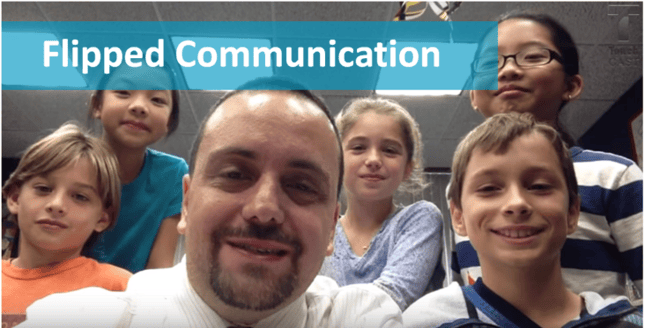Don’t Like How You Communicate? Then Flip It
Written by:
Heather Hass

“The most dangerous phrase in the language is: We’ve always done it this way.”
— Grace Hopper
Face it: No one has the time anymore to write weekly newsletters, much less hold lengthy after-school meetings. With all the technological advances of the past decade, we can now do so much more!
That’s where flipped communication comes in.
Based off the very successful flipped classroom model, flipped communication uses video technology to save you valuable time communicating with parents, staff, and administrators. More than that: It offers these audiences fascinating glimpses inside your classroom—in ways the written word can’t on its own.
WHY FLIP COMMUNICATION?
It Saves Time. How many times have you been in a meeting and thought, “All of this information could have been sent to me in an email?” Educators today have a lot on their plates and need to use their time more wisely.
It Strengthens Relationships. For parents who can’t come to parent nights because they work a third shift, don’t have a car, or travel for work, flipped communication allows them to still connect to what’s happening with their students. It also allows information to be available whenever a parent needs it. For example, they could watch your video 50 times if they need to, which plays into personalized learning.
It Builds Brands. Flipped communication can help you brand your district, your school, or even an individual classroom. After all, it takes 17 positives to drown out one negative. By posting the positive things happening in your school, you can show off your best side.
THE FLIPPED COMMUNICATOR’S TOOLBOX
So many technological tools for flipped communication are available—and new tools are coming out all the time.
Looking to get a head start on flipped communication? Try some of these free (or “freemium”) tools:
Tried one of these tools and not happy with the experience? Don’t abandon the idea of flipped communication entirely. Simply try a different tool. You’ll need to find out what works best for you and your school’s needs.
YOUTUBE: THE SECRET WEAPON
YouTube can be a great tool for educators and, in many cases, the best tool for flipped communication. It has some great advantages.
- It’s easy to set up. If you have a Google Apps account, you already have a YouTube Channel. Just log in to your Google account, go to youtube.com and click MyChannel.
- It lets you control who sees what. With YouTube, you can turn commenting on and off. You also can make videos public (so anyone on the web can find them), private (so only you can see them), and unlisted (so anyone with the video link can find it).
- It’s popular and familiar. Everyone knows YouTube. If you mention it to a parent, they won’t look at you like you’re crazy for given them another new tool to learn; they probably already know how to use it.
- It’s accessible to everyone. For the hearing impaired, YouTube has a feature that picks up what you’re saying and turns it into captions at the bottom of the screen. Even cooler: Those captions can be translated into a ton of languages, so parents who aren’t native English speakers can understand you.
TIPS AND TRICKS
Communicating with audiences through YouTube is a far cry from the newsletters and meetings of yore. While it can be an intimidating challenge for some educators, there are several tips and tricks to help you get started.
- Don’t be a restart junkie. When you create your video, it’s okay to make a mistake here and there. If you do, don’t restart your video. Just keep going. We’re humans, after all.
- Don’t use a script. If you go through the trouble of writing a script, you may as well just write a newsletter. Skip the script in favor of bullet points that’ll remind you of important events (like tests dates). Otherwise, just talk naturally.
- Have a personality. Try and be fun in your video. If you feel like you’re being overly cheesy, don’t worry. It means you’re probably doing a good job!
So put aside the old way of doing things, step out of your comfort zone, and flip your communication. It may feel strange at first, but in the long run it can save you time and help you reach a bigger audience.
Heather Haas is an Instructional Technology Specialist for Charlotte Mecklenburg Schools. She currently supports 35 schools in the district and provides teachers with professional development trainings across various topics to help them integrate technology effectively in their classrooms. Previously, Heather was a Computer Teacher for grades K-6 and a 5th Grade Teacher. She is currently pursuing a second Masters Degree is Educational Leadership. Heather grew up in New York but currently resides in North Carolina with her husband and two rescue dogs.

